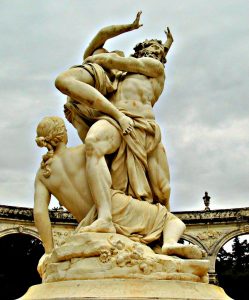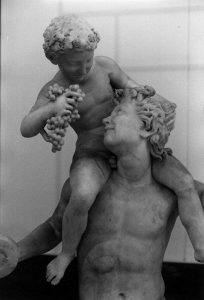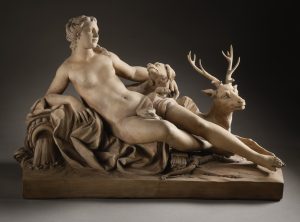
An ancient statue of Isis caring for Horus, creator unknown.
Worshipped as consort to Osiris, she is more than merely a beautiful trophy. Queens in Egypt were supposed to be wise counsellors to Pharaoh – their coronation title “She who Sees Horus and Set In One Being” suggests how important the Queen was to Pharaoh’s magical duties.
Isis is the model of queenship and motherhood. She is often depicted suckling her son Horus, who is usually portrayed as a child rather than an infant – representing his strength, and her devotion to him beyond the usual. Several depictions of the Madonna and Child are based on earlier works showing Egypt’s Great Queen
The Romans adopted Isis as another mother-goddess; it’s probable that the temple commissioned by Caesar in honour of Cleopatra was dedicated to Isis.
Story of the Goddess – The Source of the Nile
Set was always jealous of his kingly brother, Osiris. Once, to trap him, Set fashioned a box of rich acacia and cedar, and measured it to fit Osiris perfectly.
Set then gave a banquet for all the gods, and proudly displayed the box. He proclaimed that whomever it fit would get to keep it. Dwarfish Bes was too small, and great Sobek the crocodile god was too large. Set’s wife Nephthys was too slender, Hathor the hippo goddess was too wide. When it came to Osiris’s turn. Set slammed the lid, making the box into a coffin for Osiris.
Set threw the box into the Nile, and it drifted away. Isis spent a long time searching for her husband, and at last found the box with Osiris’s body. She brought it back to Egypt so that he could have a proper funeral, and be interred in a pyramid.
As he lay in state amid the drying desert sands, Set found the body and in his rage at seeing Osiris again, tore the body into 14 pieces, and scattered them all over Egypt. As far as Set was concerned, his hatred was such that his enemy should not even have a proper burial!
Once again, Isis set out to search for her husband. Try as she might, she could only find thirteen pieces of him – the last piece, his phallus, had been eaten by a great fish.
She besought Thoth’s aid, and he helped her to craft a golden phallus, and attach it to Osiris’s body. Such was the power of Isis’s magic, she was able to become pregnant by her dead husband, and she conceived Horus to be his father’s avenger.
With his body restored, and properly buried, Osiris became king of the Land of the Dead. The great fish who ate the last piece of him, swam to the end of the Nile, and there died. The phallus is there still, the source of the great fertility of the mighty river, and the author of the wealth of the land of Kem.
In your Games and Stories
Isis is patron of magicians. Her temples might be schools of magic, and her devotees and priests likely favor policies of educating peasants and universal literacy. She’s unlikely to have orders of paladins; such priests as she does have are likely to be heavily involved in politics.
As a deity of female power, the goddess might be followed by Queens and noble ladies. In any world where women have less status than their male counterparts, she might be seen as the embodiment of the power behind the throne. She could also be invoked in her motherhood role to protect youngsters.
Defunct temples are unlikely to be gem-filled dungeons – the Egyptians favoured simple open courtyards. But the magical aspects of such a place might make it an ideal location to cast large ritual spells – and even possibly be a nexus for interplanar travel.
Such a nexus might well attract The Wandering Tavern – and serve as part of the quest to anchor it once more.







